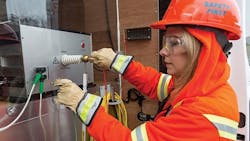Utility Proactively Tests Underground Cable
Distribution companies are continually looking for ways to improve system reliability, all while conserving capital investments and operational costs. With an aging infrastructure, one of the main issues that utilities face is a way to assess the actual condition of their capital assets.
With respect to underground cables, utilities can achieve enhanced reliability by developing a smarter asset management strategy. Historically, utilities have used a reactive-based maintenance approach: when a cable fails, have it replaced. However, with increasing proportions of cables approaching end of life, this method is not sustainable because it consumes a significant portion of the operations and maintenance budget. Simply put, for most utilities, not enough capital dollars are available to replace all of the aged cables. For this reason, an effective strategy employing condition-based maintenance must be adopted to balance this issue.
Many utilities have switched to condition-based maintenance programs to spend their capital budgets more efficiently. Generally, utilities diagnose the health of a cable based on its age, and they expect cables to last 25 to 30 years. The age of a cable, however, is not always an indication of the cable’s quality. Instead, environmental conditions such as soil moisture, operating conditions as well as changes in cable design and manufacturing variations, all contribute to a significant variation in asset condition of cables at a given age.
In order to maintain a reliable system, utility engineers must keep track of which cables are in good standing and which ones are approaching end of life. Continuous monitoring and diagnostic testing of underground cables supports the development of an appropriate asset management plan. Successful determination of the condition of capital assets will help prioritize replacement projects as well as ensure the cables being replaced actually warrant the investment, ultimately saving the company valuable resources.
Conducting a Nondestructive Test
Energy Ottawa has partnered with the National Research Council (NRC), the government of Canada’s premier research and technology organization, to help with diagnosing the health of cross-linked polyethylene (XLPE) underground power cables.
As a result of a six-year collaboration, NRC and Energy Ottawa have developed a novel method, based on the DC Polarization/Depolarization Current Measurement principle, to diagnose the quality of the cables. This is a truly nondestructive approach applying a maximum voltage of 30% of the cable’s voltage rating, whereas other health diagnostic testing further stresses cables, often requiring up to 1.5 times the cable’s voltage rating to be applied. This nondestructive service successfully determines the health of the tested XLPE cable while preserving the integrity of the cable.
In the winter of 2011, Hydro Ottawa, an affiliate of Energy Ottawa, initiated its annual underground cable-testing program with NRC. The testing method used by NRC determines the general condition of a polymer cable segment. Using this methodology, Hydro Ottawa has been able to better understand the condition of its 5,000 km of in-service XLPE cable over the past five years. In turn, the asset engineering team can effectively prioritize its cable replacement and cable injection programs. This extends the useful life of the cable and improves service to its customers.
Evaluating Results
Roughly half of Hydro Ottawa’s distribution system is underground. Of the almost 5,000 km of underground cable installed in Ottawa, more than 90% is XLPE. Field crews installed significant portions of the utility’s XLPE cables from the mid-1970s through 1990, and these are now reaching, or have surpassed, the anticipated 30-year life. Replacing all of this cable, much of it through mature backyards, would be costly and disruptive to the customers.
Cable deterioration over time, however, can lead to system failure and poor reliability. One major aging mechanism of underground XLPE cables is the development of water trees within the insulation. Water trees are small, tree-shaped channels of moisture and ionic impurities that diffuse within the insulation of an XLPE cable and propagate under the effect of an electric field. With time, water trees can grow and degrade the quality of the insulation.
A health index is used to assess the condition of the cable based on the progression of water trees. A higher value health index has shown a consistent correlation with the length and density of water trees found within the insulation. A quick on-site diagnostic technique based on measurement of the depolarization current is performed on an isolated and de-energized cable, and the results are compared to a baseline reference.
Insulation quality is also a key indication of the quality of the cable itself. The NRC method was designed for XLPE extruded cable and works effectively on medium-voltage cable. Test results clearly indicate cable condition as like new, good, fair, bad or critical. By diagnosing the insulation, this method gives an accurate representation of the health of the cable.
To date, 1.7% of the total polymer distribution cable in Hydro Ottawa’s network has been tested. More than 75% of the cables tested have been found to be in like new or good condition.
Prioritizing Replacement
Historically, the industry has used cable faults as a lagging indicator to drive replacement decisions. Hydro Ottawa has determined this approach often results in premature replacement where faults were the result of localized defects or damage, and the remaining cable is in good condition.
Cable sites targeted for testing include those scheduled for replacement, based on age or cable failures, in the next two to five years. Cable testing provides direct, nondestructive assessment of the condition of cable assets to allow for the optimization and prioritization investments in the renewal of this asset class.
All of the injection locations/areas have first been tested through the Energy Ottawa/NRC cable testing program. The decision to inject or replace is primarily driven by the economics/feasibility of injection, which considers several other installation parameters such as number of splices, specific cable design and ease of replacement. Hydro Ottawa is continuing to refine the injection decision criteria based on the program results and experience.
In today’s competitive energy market, enhancing reliability has proven to be utilities’ primary concern. Operating a system without proper consideration of the condition of assets can be detrimental, and therefore, an improved asset management strategy is imperative. Good planning ensures that money spent today will have a lasting value in the future.
Alana Jones is a testing and instrumentation EIT for Energy Ottawa and is responsible for performing diagnostic testing and analysis on underground power cables. She earned her degree in chemical engineering from Laurentian University and her electrical engineering technologist diploma from Algonquin College.
Bill Bennett is the director of distribution asset management for Hydro Ottawa. He has more than 33 years of experience in the electricity distribution industry in the areas of distribution system planning, engineering, asset management, design, construction and operation. He holds a BSEE degree from Queen’s University and an MBA from the University of Ottawa. He is also a member of the Professional Engineers of Ontario.


